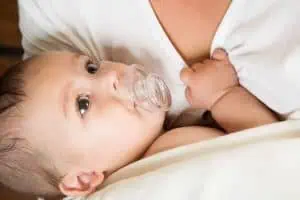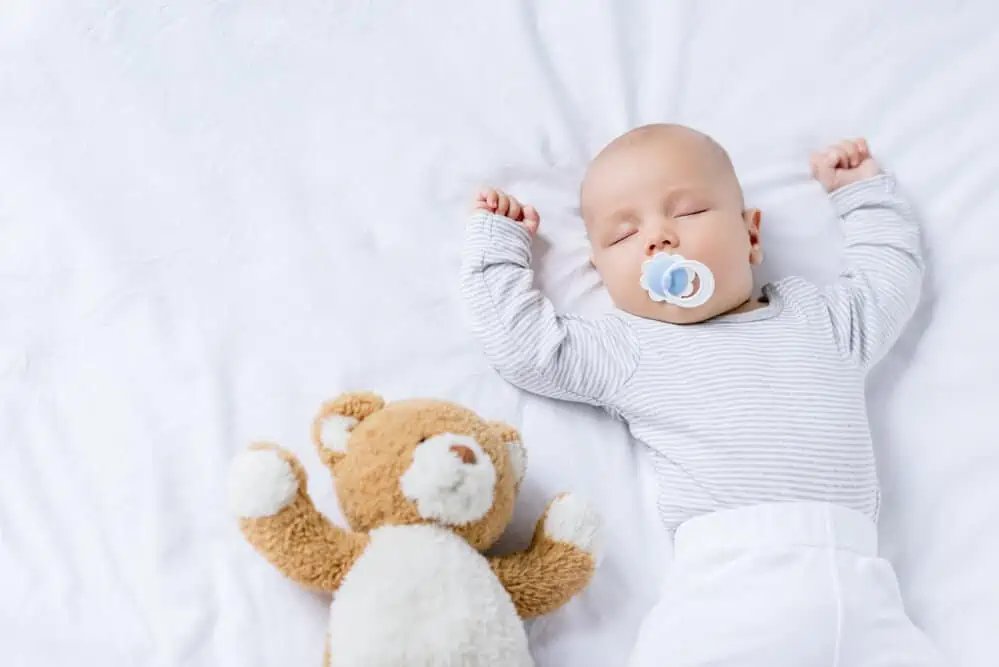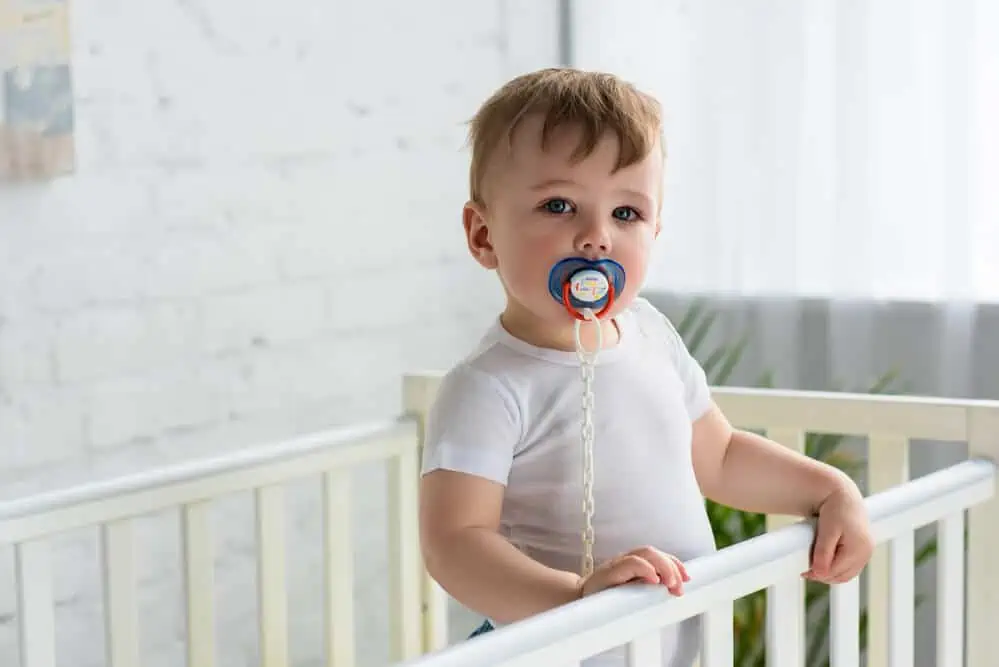Parents have been relying on newborn pacifiers to calm their kids for a long time. Also known as ‘soothers’, ‘binkys’, ‘Dodies’, or ‘teethers’, these pacifiers are silicone or plastic nipples that are given to an infant to suck on. But are pacifiers really a good idea? Some experts say no, and one of the primary reasons for this is pacifier teeth.
As a parent, of course you want to do the right thing for your child. So, in this article, we’ll answer the following questions:
- What are pacifier teeth?
- Are they reversible?
- Is it ok to give a pacifier to your newborn?
Keep reading to get answers to all of these questions and make smart decisions when it comes to using pacifiers for your little ones. And have a look at our entire collection of articles dedicated to dental care for babies and children.
What are pacifier teeth?
Pacifier teeth refers to a condition that occurs from the prolonged use of pacifiers. The teeth of a baby start developing in the womb and continue to develop and grow throughout their childhood. During this time, anything kept in a baby’s mouth for prolonged periods can negatively affect their oral and dental development.


Why are pacifier teeth such a big deal?
Just like babies sucking their thumbs can lead to oral problems in childhood, pacifiers could also end up harming their mouths more than benefitting them, especially when used for too long. As per the American Dental Association, using pacifiers can lead to a handful of side effects that include:
- Crooked or crowded teeth
- Jaw misalignment
- Problems with biting
- Protrusion of the tongue
- Changes in the roof of the mouth
- Change in the position of teeth
In other words, using a newborn pacifier has multiple potential side effects for a baby’s teeth. Sometimes, pacifiers may even necessitate the use of braces in the future.
This raises important questions for many parents to consider: Why use a pacifier at all? Should I use one with my baby? Let’s find out.
Pros and cons of using pacifiers
Despite what most people believe about pacifiers, it is important that you make your own decision. To do this, it can help to familiarize yourself with the common advantages and disadvantages of these soothing tools.
The pros
For many parents with a newborn or an infant at home, pacifiers can be a favorite go-to accessory. Pacifiers successfully help countless adults calm distressed children.
There are also some indications that pacifiers can be good for babies. Many rely on this tool to calm their children and let them go to sleep peacefully. In fact, up to 75 percent of babies in the West are said to use pacifiers at some point in their lives.
Despite a high risk of pacifier teeth damage, these tools are a key to contentment for many babies between mealtimes. Consider the following advantages of using a pacifier in children.
A pacifier can:
- Calm a fussy baby.
- Act as a temporary distraction.
- Distract a child after a painful procedure such as a blood test or vaccine shots.
- Help your child fall asleep.
- Make airplane travel easier for babies.
- Be thrown away; babies sucking a thumb or their fingers have a harder time stopping because you can’t get rid of a finger!
In addition to these benefits, some studies also suggest that a pacifier used before falling asleep reduces the risk of sudden infant death syndrome (SIDS). Sudden infant death syndrome, or SIDS, is the most common cause of fatalities in babies between the ages of 1 month to 1 year. According to the American Academy of Pediatrics (AAP), pacifiers can reduce the risk of SIDS even after the pacifier falls out of the baby’s mouth once they fall asleep.
Have a look at the top eight Do’s and Don’ts of pacifier use:
The cons
Despite being a lifesaver for many sleep-deprived parents, pacifiers still have certain problems. These disadvantages are mentioned below and should be considered while deciding whether you want your child to use a pacifier or not.
- May cause nipple confusion in breastfed babies
- Your child may become dependent on the pacifier
- Increased risk of ear infections
- Increased risk of dental problems like pacifier teeth and misaligned teeth, which could later lead to braces for kids
Mentioned below are the benefits and risks of using a pacifier in children of different age groups, according to this study.
| Age | Potential benefits | Potential complications |
| Pretern infants | Pain relief, decreased hospital stay, improved bottle feeding performance | None |
| Up to 6 months | Pain relief, reduced risk of SIDS | Early breast weaning |
| 6 months – 2 years | None | Ear infection |
| 2+ years | None | Dental malocclusion |
Using a pacifier safely
If you do decide to give your child a pacifier, here are some ways you can use it safely and stop them becoming too dependent on it:
- Don’t ever force your child to use a pacifier. If they are asleep and it falls out without waking up the baby, do not attempt to put it back in.
- Never coat the pacifier with anything, for example, sugar or honey, just to encourage the baby to use it.
- Buy orthodontic pacifiers which are specially shaped to reduce the chances of pushing teeth forward.
- Do not add a ribbon or a tie to the pacifier. Moreover, do not tie it to the cot or around your child as this increases the risk of accidental strangulation.
- Always try alternative methods to calm your baby before using a pacifier.
- When they start learning to talk, encourage them to remove the pacifier and speak rather than grunting or pointing.
Pacifiers and emotional comfort
Many experts ask parents to break the pacifier habit sooner rather than later. This is because, besides oral health issues, it can become a source of emotional comfort in many children.
If your baby has gone through the reflexive sucking stage of using a pacifier and still refuses to leave it (after age 6 months to 1 year), chances are they have developed an emotional attachment to it. In these circumstances, breaking the pacifier habit can be quite difficult.


If your child has already found emotional comfort in a pacifier, do not worry. It is never too late to make things right. There are many online resources that can help break the habit of finding comfort in a pacifier.
Questions to ask your doctor regarding pacifiers
Here are some of the questions you should ask your doctor regarding pacifiers:
- Will my baby get a pacifier from the hospital when they are born?
- Are hospital pacifiers safe?
- Is the plastic used to make the pacifier toxic?
- Is it unkind to let the baby cry while weaning them from pacifiers?
Stopping pacifier use
Does your baby use a pacifier too much? Are you afraid they are going to develop pacifier teeth? There are certain ways to get rid of the pacifier habit. Some of these tips are mentioned below.
- Gradually limit pacifier use (only in the house, only in the crib. etc.)
- For toddlers, offer a special toy or prize in exchange for the pacifier.
- Provide another source of comfort like a blanket or stuffed animal.
- Try the ‘cold turkey’ approach and immediately take it away, but use positive reinforcement.
- Make sure all of Baby’s caregivers are on board with the weaning plan.
- Be prepared for tears, but remember that giving the pacifier back after crying will reinforce to the child that the reward for crying is the pacifier.


The most suitable time to stop pacifier use in children to avoid pacifier teeth can be determined with the help of a doctor. In most cases, parents tend to break the habit between 6 months to 1 year of age. The use of a pacifier is discouraged in children above the age of 4 years.
Conclusion
Pacifiers are a great way to calm a crying baby, but there is a proper place and time to use them before they become more harmful than useful. In addition to learning about the pros and cons, it’s not a bad idea to speak with a dentist about your concerns. Remember, pacifiers can lead to several problems like the development of pacifier teeth which can only be reversed with proper medical care.
The dentist can keep an eye on the dental health of your child as they grow, and make sure that they can use pacifiers without developing pacifier teeth.
FAQs
Will pacifier teeth correct themselves?
The simple answer is no. Once your baby has developed pacifier teeth, there is no way to correct themselves naturally. Almost every case requires proper medical intervention and correction. Prevention is the best cure in this scenario.
Is it okay for my baby to have a pacifier during sleep?
Even if your baby is not crying, using a pacifier can help them go to sleep faster, which ultimately means more sleep for the parent too. However, this practice risks accidental swallowing and choking. So, be extremely cautious if you are giving your baby a pacifier at night.
Should I coat the pacifier with candy?
Absolutely not. Just think about it: You are giving your little one something covered in sugar and allowing them to suck on it for a long duration of time. This can lead to tooth decay. Tooth decay is something parents and babies certainly don’t want or need. So, avoid coating it with anything and never force your child to use it when they don’t want to.
When should children stop using pacifiers?
According to both AADP and ADA, the use of pacifier must be actively discouraged, either gradually or cold turkey, in children as soon as they reach the age of 4 years, if not sooner.
How often should you replace a pacifier?
While there is no fixed answer to this question, it is generally advised to check the pacifier before giving it to your baby every time. It must be thrown away as soon as you detect the first signs of weakness or damage. As a rule of thumb, most experts advise changing the pacifier every two months in order to maintain good hygiene.
American family physician: Risks and benefits of pacifiers. Consulted 5 March 2020.
Journal of pediatric nursing: A comprehensive review of evidence and current recommendations related to pacifier usage. Consulted 5 March 2020.
University of Rochester, Medical Center: How to use a pacifier. Consulted 5 March 2020.
Pediatrics journal: SIDS and Other Sleep-Related Infant Deaths: Updated 2016 Recommendations for a Safe Infant Sleeping Environment. Consulted 5 March 2020.
Journal of Pediatrics and Child Health: Dummy (pacifier) use and sudden infant death syndrome: Potential advantages and disadvantages. Consulted 5 March 2020.
American Dental Association: Thumb sucking and pacifier use. Consulted 5 March 2020.
NCBI: Pacifiers (soothers): A user’s guide for parents. Consulted 20 March 2020.
Parenting.nytimes.com: How to Ditch the Pacifier. Consulted 20 March 2020.
American family physician: Risks and benefits of pacifiers. Consulted 5 March 2020.
Journal of pediatric nursing: A comprehensive review of evidence and current recommendations related to pacifier usage. Consulted 5 March 2020.
University of Rochester, Medical Center: How to use a pacifier. Consulted 5 March 2020.
Pediatrics journal: SIDS and Other Sleep-Related Infant Deaths: Updated 2016 Recommendations for a Safe Infant Sleeping Environment. Consulted 5 March 2020.
Journal of Pediatrics and Child Health: Dummy (pacifier) use and sudden infant death syndrome: Potential advantages and disadvantages. Consulted 5 March 2020.
American Dental Association: Thumb sucking and pacifier use. Consulted 5 March 2020.
NCBI: Pacifiers (soothers): A user’s guide for parents. Consulted 20 March 2020.
Parenting.nytimes.com: How to Ditch the Pacifier. Consulted 20 March 2020.




